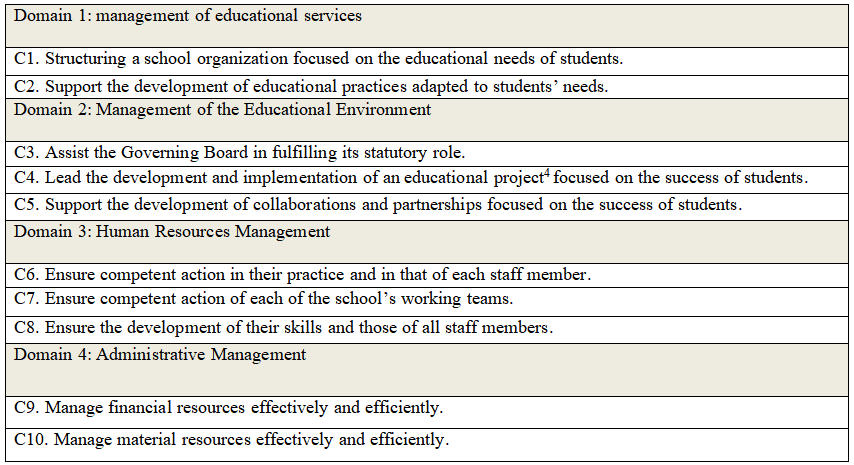COVID-19 Crisis Management in Schools: A Look at the Skills and Practices of Québec’s School Principals
Main Article Content
Article Details
References
[1] Institut national de la santé publique du Québec (INSPQ) (2021). Ligne du temps COVID-19 au Québec.
[2] Lemieux O., Bernatchez J. and Delobbe A.-M. (2021). Gestion de crise et éducation au Québec : les représentations des directions d’établissement sur les rôles et les responsabilités des acteurs scolaires en temps de COVID-19. Interventions économiques, 66, 1-20. https://doi.org/10.4000/interventionseconomiques.14403
[3] Lemieux O., Bernatchez J. and Delobbe A.-M. (2020). Gestion de crise en milieu scolaire. CTREQ.
[4] Ministère de l’Éducation, du Loisir et du Sport (2008). La formation à la gestion d’un établissement d’enseignement. Les orientations et les compétences professionnelles. Québec : Gouvernement du Québec. http://www.education.gouv.qc.ca/fileadmin/site_web/
[5] Brassard A. (2009). De principal d’école ou supérieur à directeur d’établissement au primaire et au secondaire (1840-2009). Le Point en administration de l’éducation, 12 (1), 9-15.
[6] Commission Parent (1964). Rapport Parent, Tome II. Gouvernement du Québec.
[7] Bernatchez J. (2011). La formation des directions d’établissement scolaire au Québec : apprendre à développer un savoir-agir complexe. Télescope, 17 (3), 158-175.
[8] Ministère de l’Éducation du Québec (2001). La formation à l’enseignement : les orientations, les compétences professionnelles. Québec : Ministère de l’Éducation du Québec.
[9] Ministère de l’Éducation du Québec (2020). Référentiel compétences professionnelles : profession enseignante. Québec : Ministère de l’Éducation du Québec.
[10] Conseil superieur de l’éducation (2019). Projet de règlement modifiant le Règlement sur les autorisations d’enseigner. Avis au ministre de l’éducation et de l’enseignement supérieur. Gouvernement du Québec.
[11] Libaert T. (2018). Communication de crise. Pearson.
[12] Bergamo L. (2017). Communication de crise et systèmes d’alerte socionumériques : de nouveaux outils pour répondre aux attentes des publics en situation de crise? Master, Université du Québec à Montréal, Archipel UQAM.
[13] Boumrar J. (2010). La crise : levier stratégique d’apprentissage organisationnel. Vie & sciences de l’entreprise, 185-186 (3), 13-26.
[14] Harvard Business Essentials (2011). L’essentiel pour manager en temps de crise. ESF Editor.
[15] Heiderich D. (2010). Plan de gestion de crise. Dunod.
[16] Roux-Dufort C. (2009). Une théorie de la crise en sciences de gestion. Cachan : Lavoisier.
[17] Kavrayıcı C., and Kesim E. (2021). School management during the COVID-19 pandemic: A qualitative study. Kuram ve Uygulamada Eğitim Yönetimi, 27(1), 1005-1060. https://doi.org/10.17762/kuey.v27i1.4
[18] Kaul M., VanGronigen B. A. and Simon N. S. (2020). Calm during crisis: school principal approaches to crisis management during the COVID-19 pandemic. CPRE Policy Briefs, 1-12.
[19] Tamtik M. and Darazsi S. (2022). Navigating Turbulent Waters : Leading One Manitoba School in a Time of Crisis. Canadian Journal of Educational Administration and Policy/Revue canadienne en administration et politique de l’éducation, (200), 22-36. https://doi.org/10.7202/1092705ar
[20] Savoie-Zajc, L. (2009). L’entrevue semi-dirigée. In: Gauthier B. (ed.). Recherche sociale. De la problématique à la collecte des données (pp. 337-360). Presses de l’Université du Québec.
[21] Clément L. (2014). La gestion d’un établissement d’enseignement privé québécois : Réflexion centrée sur l’organisation du travail des directeurs-trices. Revue Canadienne des Jeunes Chercheur (e) s en Éducation, 5 (2), 82-91.
[22] Van der Maren J.-M. (2004). Méthodes de recherche pour l’éducation. Éducation et formation. Fondements. Presses de l’Université de Montréal.
[23] Krumpal I. (2013). Determinants of social desirability bias in sensitive surveys: a literature review. Qual Quant, 47(4), 2025-2047. https://doi.org/10.1007/s11135-011-9640-9
[24] STRIEPE, M., and CUNNINGHAM, C. (2021). Understanding educational leadership during times of crises: a scoping review. Journal of Educational Administration, 60(2), 133-147. https://doi.org/10.1108/JEA-03-2021-0057
[25] ADAMS, D., CHEAH, K., THIEN, L., and MD YUSOFF, N. (2024). Leading schools through the COVID-19 crisis in a South-East Asian country. Management in Education, 38(2), 72-78. https://doi.org/10.1177/08920206211037738
[26] BRION, C. and KIRAL, B. (2021). COVID-19 Crisis Challenges and Management Strategies of Educational Leaders in America. International Journal of Contemporary Educational Research,8(4), 170-183.https://doi.org/10.33200/ijcer.943568
[27] HAYES, S.D. and DERRINGTON, M. L. (2023) School leadership in uncertain times: identifying dimensions of effective principal leadership, School Leadership & Management, 43:4, 330-347, DOI: 10.1080/13632434.2023.2171002
[28] SMITH, L. and RILEY, D. (2012). School leadership in times of crisis. School Leadership & Management, 32(1), 57-71. https://doi.org/10.1080/13632434.2011.614941
[29] Judge T. A., Hofmans J. and Wille B. (2017). Situational Judgement Tests and Personality Measurement: Some Answers and More Questions. European Journal of Personality, 31(5), 463-464.
[30] Kapucu N., and Ustun Y. (2017). Collaborative Crisis Management and Leadership in the Public Sector. International Journal of Public Administration, 41(7), 548-561. https://doi.org/10.1080/01900692.2017.1280819
[31] Mathews J. (2022). Crisis Leadership: The Cognitive-Affective Personality Traits Approach. IUP Journal of Soft Skills, 16 (4), 22-43.
[32] Robert B. and Lajtha C. A. (2003). New Approach to Crisis Management. Journal of Contingencies and Crisis Management, 10(4), 181-191.
[33] Guion R. M. (2011). Assessment, measurement, and prediction for personnel decisions (2 ed.). Routledge.
[34] GRISSOM, J. A. and CONDON, L. (2021). Leading Schools and Districts in Times of Crisis. Educational Researcher, 50(5), 315-324. https://doi.org/10.3102/0013189x211023112
[35] Samir Z. (2020). The Role of Decision‐maker in Crisis Management: A qualitative Study Using Grounded Theory (COVID‐19 Pandemic Crisis as A Model). Journal of Public Affairs, 20(4), 1-11. https://doi.org/10.1002/pa.2186

This work is licensed under a Creative Commons Attribution 4.0 International License.

